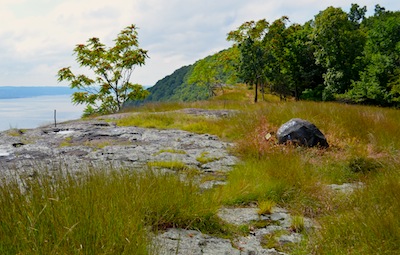 by Marcy Denker
by Marcy Denker
At the top of the escarpment along the Hudson River, a short steep climb through the woods north of Rockland Lake, is Hook Mountain. The grand view from this favorite destination for hikers captures the river and sky from a sort of penthouse garden with a floor of grass and stone. I went there the other day to see whether a “strike” had been carried out on the invasive vine called black swallow wort. A couple of weeks earlier I had found patches of it growing among the path rush, bottlebrush grass, and little bluestem. If the swallow wort were to displace these native grasses, the beauty and the ecological health of the place would be diminished.
Large, tangled swaths of swallow wort have proliferated along the Long Path farther south and along the bike path below. Removing the relatively small patches here seemed to make sense, and I checked with Linda Rohleder the Coordinator of the New York New Jersey Trail Conference’s Invasive Species Strike Force and the new leader of the Lower Hudson Partnership for Regional Invasive Species Management (PRISM). She agreed and arranged to send Keith Shane, a Cornell University biology student who spent the summer as an intern with the Strike Force, to do the job.
When I reached the spot the other day I found patches of yellowing leaves and little yellow warning signs that marked a pesticide application. The plant has an extensive underground root system, making manual removal difficult, and in mid-summer the seed pods split open. Disturbing the plants could send thousands of seeds on little silky parachutes far and wide. So a two percent solution of glysophate (the active ingredient in RoundUp) was used. Next year there will be more work to do.
Back down below along the road to the river trail is a burgeoning woodland landscape of aliens in flux. A newcomer, mile-a-minute vine, now clambers over mugwort, Japanese stiltgrass, and wineberry. The ubiquitous Norway maple dominates the canopy. Chances are that all of these invasive plants will be left alone to do what they will. With limited resources, parks managers will target high value spots, like the one on the ridge where there is an established landscape of predominantly native plants and a relatively small amount of invasive plants. In other cases the presence of a threatened or endangered plant will determine the approach.
Invasive plant species are identified based on the harm that they can do to the environment. Not all introduced plants become invasive, and there are gray areas in determining harm. But, generally, when describing the most troublesome actors that compete for territory in our parks, along roads and in our gardens it’s clear that any benefits these introduced plants provide are heavily outweighed by the costs. They displace species that provide much more value, and they bring along negative side effects.
Take Japanese barberry, a common landscape shrub that has come to dominate sections of the understory in woods throughout the region. Birds disperse the seeds, and the shrubs quickly displace native vegetation, deplete the soil, and create an environment that appeals to white footed mice, which carry Lyme Disease. Earthworms (another introduced species!) also like the barberry habitat, and eat the leaf litter that would otherwise build up on the ground and create healthy soil hydrology. As a result, barberry infested areas are prone to soil erosion.
Some invasive plants are familiar in our gardens either as weeds, like mugwort, or as ornamentals, like Japanese barberry and privet. It’s easy to get to know the top invasive species in our area using the internet. The NYS DEC’s Advisory Invasive Plant List ranks key species of high or very high concern. Other sites provide factsheets like this one from the USDA with detailed plant descriptions. They also give recommended control methods, which is just as important. Using the wrong method can sometimes be wasted effort, or even do more harm than good.
Once aware of plants like these it’s hard to miss them along streets, highways, train lines, and in our yards. And as entomologist Douglas Tallamy has argued, to the delight of many readers, it’s in our yards that is will be easiest to do something to make a positive difference. In Bringing Nature Home, Tallamy advocates naturalistic gardens using native plants to support local wildlife, starting with the insects. The book is a rallying cry to suburban gardeners to design their yards to provide food and habitat for native bees, butterflies and other insects because many of these coevolved with certain native plants and need them to survive.
For these “specialists,” introduced plants in the same family won’t do. Consider the monarch butterfly, whose larvae have evolved to eat native milkweeds. Milkweed populations have declined due to the use of the herbicide glysophate in agriculture, and so monarch populations are down too. The alien black swallow wort on Hook Mountain is in the milkweed family and plays host to the monarch, but while the butterflies lay their eggs on it, the larvae don’t survive. By adding native milkweeds to our gardens we can support the monarchs.
There are plenty of terrific resources for native gardeners on the internet and on the ground. The downloadable Finding Alternatives to Invasive Ornamental Plants in New York shows native substitutes for common introduced ornamental plants. In Designing Gardens with the Flora of the American East landscape architect Carolyn Summer’s describes the fundamentals of designing for wildlife and shows how to use native plants in traditional gardens. The Native Plant Center on the campus of Westchester Community College offers a series of short courses, hosts an annual native plant sale, and maintains two demonstration gardens. And this spring the new 3.5 acre Native Plant Garden opened at the New York Botanical Garden.
Native plant gardening has been a strong trend all through the decades of my career as a landscape designer, but today it’s clearer why it matters and how to make a positive difference. Sustainable landscape design, planning, and land management strategies seek to increase biodiversity, slow extinctions, and maximize ecosystem services. As we adjust our sites, we are adjusting our sights, looking beyond the garden fence to wilder places to protect them and bring their lessons home.
Landscape Designer Marcy Denker, ASLA, lives in Nyack, NY.








